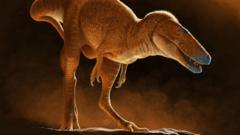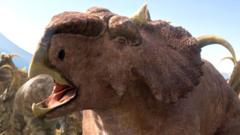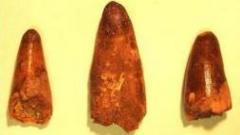The recent discovery of a new dinosaur species, Khankhuuluu mongoliensis, reveals previously unknown evolutionary links within the tyrannosaur family tree, indicating a complex history for these fierce predators.
Newly Unearthed Dinosaur Species Challenges T. rex Evolutionary Lineage

Newly Unearthed Dinosaur Species Challenges T. rex Evolutionary Lineage
Exciting findings reveal a new dinosaur species that could redefine the family tree of tyrannosaurs.
In an astonishing new find, scientists at a Mongolian museum have uncovered a dinosaur species that they argue may fundamentally change our understanding of tyrannosaur evolution. The two skeletons, dating back approximately 86 million years, are classified as Khankhuuluu mongoliensis, translating to "Dragon Prince of Mongolia." This species is now thought to be the closest known ancestor of all tyrannosaurs, a family that includes the legendary T. rex.
The discovery, featured in the journal Nature, offers vital clues into the transition of tyrannosaurs from smaller, agile hunters to larger predators that dominated North America and Asia during the reign of dinosaurs. Prof. Darla Zelenitsky, a paleontologist at the University of Calgary, explained that the term "Prince" in the name reflects the dinosaur's smaller size compared to its descendants.
The first tyrannosauroids were tiny, quick-moving predators who coexisted with larger dinosaurs. With Khankhuuluu estimating at around 750 kg compared to T. rex's massive weight of nearly eight times that, it represents an important evolutionary step in terms of size and predatory capability.
This discovery has prompted a reevaluation of existing theories surrounding the evolution of tyrannosaurs, illustrating the development of key traits such as robust skull anatomy and formidable jaw strength. Jared Voris, a PhD student involved in the research, pointed out that features seen in Khankhuuluu’s nasal bones paved the way for the powerful bite strength later seen in T. rex.
Fossils of the species were initially discovered in Mongolia in the early 1970s, but were misclassified under a different genus known as Alectrosaurus. Voris’ analysis revealed the distinctive adaptations that warranted a new species classification. The geographic movement of these dinosaurs between Asia and North America via ancient land bridges likely accelerated the diversification of tyrannosaur groups over millions of years.
In summary, this newly discovered species serves as a reminder of the past evolutionary stages of tyrannosaurs, suggesting that before they became the apex predators, they were but "princes" in a vast dinosaur kingdom.
The discovery, featured in the journal Nature, offers vital clues into the transition of tyrannosaurs from smaller, agile hunters to larger predators that dominated North America and Asia during the reign of dinosaurs. Prof. Darla Zelenitsky, a paleontologist at the University of Calgary, explained that the term "Prince" in the name reflects the dinosaur's smaller size compared to its descendants.
The first tyrannosauroids were tiny, quick-moving predators who coexisted with larger dinosaurs. With Khankhuuluu estimating at around 750 kg compared to T. rex's massive weight of nearly eight times that, it represents an important evolutionary step in terms of size and predatory capability.
This discovery has prompted a reevaluation of existing theories surrounding the evolution of tyrannosaurs, illustrating the development of key traits such as robust skull anatomy and formidable jaw strength. Jared Voris, a PhD student involved in the research, pointed out that features seen in Khankhuuluu’s nasal bones paved the way for the powerful bite strength later seen in T. rex.
Fossils of the species were initially discovered in Mongolia in the early 1970s, but were misclassified under a different genus known as Alectrosaurus. Voris’ analysis revealed the distinctive adaptations that warranted a new species classification. The geographic movement of these dinosaurs between Asia and North America via ancient land bridges likely accelerated the diversification of tyrannosaur groups over millions of years.
In summary, this newly discovered species serves as a reminder of the past evolutionary stages of tyrannosaurs, suggesting that before they became the apex predators, they were but "princes" in a vast dinosaur kingdom.










